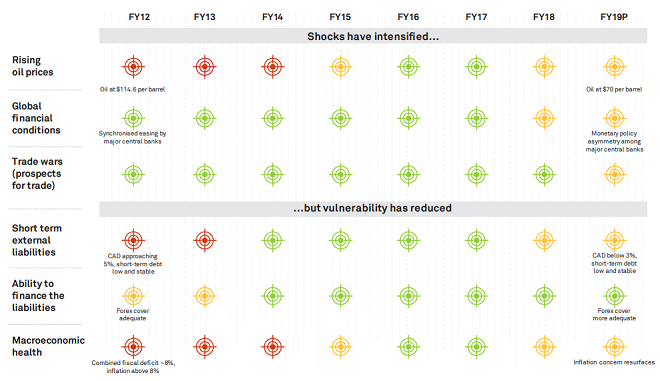After a smooth three-and-a-half year run, the Narendra Modi government began experiencing troika of looming global risks to the Indian economy late last year. Since the start of 2018, foreign investors fled debt and equities, trade deficit swelled and precipitated a fall in the rupee, and crude oil prices continued to be volatile. However, as compared with 2013, Indian economy is more resilient and looks better-prepared, rating agency Crisil said in a report.
“Though most of India’s macro parameters have seen some strain lately, they also appear resilient when compared with the 2013 ‘taper tantrum’, and in better shape than other emerging markets to negotiate the latest onslaught of
global risks,” Crisil said.
To begin with, India’s foreign exchange reserves held by the RBI are more than sufficient to finance the overall set of liabilities. India’s fiscal deficit is also healthier as compared with the previous government as the Narendra Modi government made some headway on the fiscal consolidation path. Moreover, despite oil price risk, inflation is India is fifth lowest among all emerging economies.





And yet, risks can’ be ignored. Crisil suggested that India would do good if it keeps an ear to the ground on oil price risks stemming from geopolitical tensions, especially between the US and Iran, escalation of tariff-war, and hike in policy rates too soon or too late, with serious repercussions for capital movement. “Going forward, while the risks from rising crude oil prices could ease, those from asymmetric monetary policies and trade protectionism could persist,” the rating agency said.
India’s Macro Picture in Nutshell:
- India’s headline economic indicators are relaying some not-so-good news at present
- Current Account Deficit has slid from 0.1% beginning fiscal 2017 to 1.9% end fiscal 2018, plumbing 2.5% in between
- Fiscal deficit target of 3.2% was breached last fiscal, and revised upward for this year
- Inflation has been marching up in the past few months. The Reserve Bank of India in June 2018 raised its inflation forecast and hiked policy rate after a gap of four-and-a-half years
- All this has quickly translated into a weakening rupee against the US dollar. It depreciated 7.9% on average from January to July 2018, as result of foreign capital flight from the Indian equity and debt markets and appreciation of the US dollar
- A worsening rupee makes our imports costlier and adds to domestic inflation


















